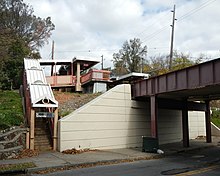Embankment (earthworks)



An embankment is a raised wall, bank or mound made of earth or stones, that are used to hold back water or carry a roadway. A road, railway line, or canal is normally raised onto an embankment made of compacted soil (typically clay or rock-based) to avoid a change in level required by the terrain, the alternatives being either to have an unacceptable change in level or detour to follow a contour. A cutting is used for the same purpose where the land is originally higher than required.
Materials
[edit]Embankments are often constructed using material obtained from a cutting. Embankments need to be constructed using non-aerated and waterproofed, compacted (or entirely non-porous) material to provide adequate support to the formation and a long-term level surface with stability. An example material for road embankment building is sand-bentonite mixture often used as a protective to protect underground utility cables and pipelines.[1]
Intersection of embankments
[edit]To intersect an embankment without a high flyover, a series of tunnels can consist of a section of high tensile strength viaduct (typically built of brick and/or metal) or pair of facing abutments for a bridge.[clarification needed]
Notable embankments
[edit]- Burnley Embankment: The largest canal embankment in Britain.
- Harsimus Stem Embankment: The remains of a railway built by the Pennsylvania Railroad in Jersey City, New Jersey, United States
- Stanley Embankment: A railway, road and cycleway that connects the Island of Anglesey and Holy Island, Wales. It carries the North Wales Coast Line and the A5 road.
See also
[edit]References
[edit]- ^ Zakarka, Mindaugas; Skuodis, Šarūnas; Šiupšinskas, Giedrius; Bielskus, Juozas (1 January 2021). "Compressive strength and thermal properties of sand–bentonite mixture". Open Geosciences. 13 (1): 988–998. Bibcode:2021OGeo...13..289Z. doi:10.1515/geo-2020-0289. ISSN 2391-5447.
External links
[edit]- Federal Highway Administration Design Manual: Deep Mixing for Embankment and Foundation Support Federal Highway Administration
Works cited
[edit]- Scott, J., Loveridge, F., & O'Brien, A. S. (2007). of climate and vegetation on railway embankments[permanent dead link].
| Investigation and instrumentation |
| ||||||
|---|---|---|---|---|---|---|---|
| Soil |
| ||||||
| Structures (Interaction) |
| ||||||
| Mechanics |
| ||||||
| Numerical analysis software | |||||||
| Related fields | |||||||
Text is available under the CC BY-SA 4.0 license; additional terms may apply.
Images, videos and audio are available under their respective licenses.
